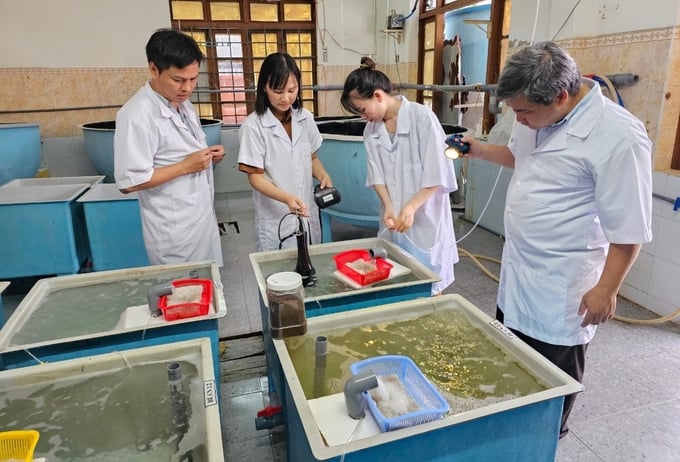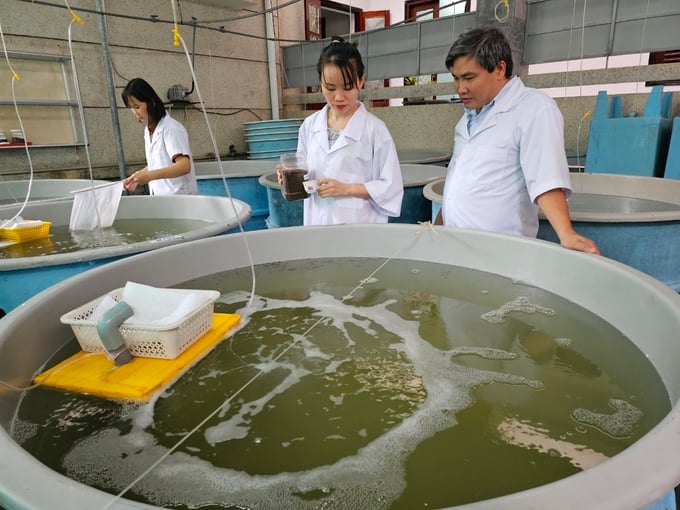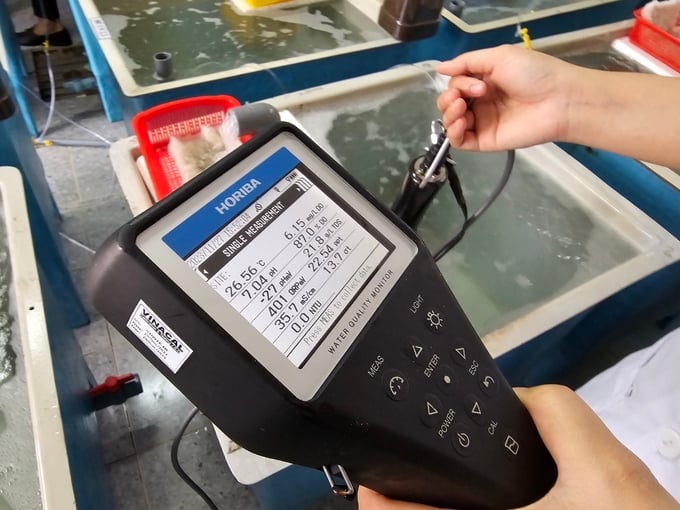November 20, 2025 | 15:48 GMT +7
November 20, 2025 | 15:48 GMT +7
Hotline: 0913.378.918
November 20, 2025 | 15:48 GMT +7
Hotline: 0913.378.918

Scientists from Research Institute for Aquaculture III have conducted a barramundi farming experiment to determine the waste load during the mariculture process. Photo: KS.
It is necessary to determine the waste load in mariculture to promote the development of offshore mariculture. In this regard, the Prime Minister has issued Decision No. 1664/QD-TTg on October 4, 2021, approving the Project on the Development of Mariculture in Vietnam until 2030, with a vision towards 2045. The project sets the goal of developing mariculture into a large-scale, industrial, synchronized, safe, efficient, sustainable, and environmentally friendly commodity production sector, whereby branded products will be manufactured to meet the domestic and export market demands.
With the advantage of long coastlines and numerous bays, provinces in the South Central region have utilized their inherent potential to develop cage mariculture. Main local aquaculture species including various marine fish (barramundi, golden pompano, cobia, etc.) and lobster (spiny lobster, ornate rock lobster, mud spiny lobster), are primarily raised in cages and traditional raft systems.
Offshore mariculture in the South Central region has brought substantial economic benefits to local farmers as well as made a significant contribution to the economic structure of the coastal regions. On the other hand, cage mariculture activities generate a noticeable volume of waste at sea, contributing to the deterioration of the environmental quality in enclosed bays. Despite the observable impact on the marine environment, there is currently limited quantified information available for the volume of waste generated through mariculture activities.

The experimental farming model involves establishing three independent variables, each repeated three times, to identify the sources of both dissolved and non-dissolved waste. Photo: KS.
According to the annual environmental monitoring results in select provinces, including Phu Yen and Khanh Hoa, conducted by the Research Institute for Aquaculture III (Institute III), the sea cage shrimp farming areas in Xuan Dai Bay, Van Phong Bay, and Cam Ranh Bay exhibit periodic monitoring indicators which exceed allowable limits several times throughout the year. These exceeded indicators include ammonia, nitrite, nitrate, phosphate, chemical oxygen demand, coliform density, vibrio, etc., found in both coastal water samples and water from shrimp cage farming areas.
Subsequently, the Ministry of Agriculture and Rural Development assigned Institute III to lead the task of establishing a scientific foundation, and collecting data on pollution sources and waste load from mariculture activities in the South Central region from 2023 to 2025.
Barramundi, which is a type of seabass, play a significant role in global mariculture, especially in Southeast Asian countries. They can thrive in both saltwater and freshwater, are easy to farm, grow rapidly, and boast high nutritional value, making them a focus for industrial-scale mariculture.
Consequently, Institute III is conducting studies on the barramundi, in conjunction with two other economically valuable species, lobster and oysters, to determine the waste load from cage mariculture. Notably, scientists at Institute III conducted a barramundi farming experiment in 2023 to assess the waste load from mariculture activities. The experimental model is implemented in two stages: the seedling stage and the commercial farming stage. Both of the stages are carried out in composite tanks to evaluate the waste load at each stage of production.

The research team monitors environmental factors on a daily basis. Photo: KS.
Master Vo Thi Ngoc Tram, Deputy Director of the Environmental Monitoring and Aquatic Disease Center for the Central Region (a unit under Institute III), and leader of this scientific task, shared that each stage assigned with an independent variable, with each repeated 3 times. These variables include traditional farming using natural feed, industrial farming with commercially available feeds, and a control group with three tanks not containing barramundi.
On a daily basis, the research team monitors basic water environmental factors such as temperature, pH, dissolved oxygen (DO), salinity, among others. Additionally, the team records the discharged waste and excess feed volume to calculate the waste load over specific time intervals.
According to Master Vo Thi Ngoc Tram, the research team takes two main waste sources into account for the calculation of the total waste load from mariculture activities. The two sources include: dissolved waste source, calculated through key indicators such as total nitrogen and total phosphate; non-dissolved organic waste source calculated through key indicators such as excess feed and fish excrement.
"To month, we have conducted the experiment for nearly 2 months, with a high survival rate of the farmed barramundi. We have also extracted sufficient data to begin evaluating the waste load from barramundi farming under experimental conditions," shared Master Vo Thi Ngoc Tram.
Assoc. Prof. Dr. Vo Van Nha, Deputy Director of Institute III, stated that the assessment of waste sources and waste load in mariculture is a necessary and crucial solution to determine a suitable stocking density and avoid overloading the mariculture environment. This task has been assigned to Institute III by the Ministry of Agriculture and Rural Development in 2023.
According to Assoc. Prof. Dr. Vo Van Nha, the research team has been tasked with assessing the state of waste generation from mariculture activities, identify waste sources and waste load in mariculture with different species. Subsequently, the team will propose suitable technical and management solutions to develop sustainable mariculture.
"The technical and management solutions to reduce waste load from mariculture activities also contribute to the sustainable development of Vietnam's mariculture as a whole," emphasized Assoc. Prof. Dr. Vo Van Nha.
According to Assoc. Prof. Dr. Vo Van Nha, the research team at Institute III conducted an assessment towards the end of 2023 on waste sources and waste load from the experimental barramundi farming activities, utilizing different types of feed corresponding to traditional and current industrial farming practices. This assessment allows the team to calculate the load of non-dissolved organic waste and dissolved waste during the farming process. Consequently, results of the assessment will serve as a basis for the research team to calculate the waste load for the current cage mariculture system and, in conjunction with other studies, assess the waste capacity of a specific marine area.
Translated by Nguyen Hai Long

(VAN) This is the study conducted by IRRI and Can Tho University on the rice straw value chain in Mekong Delta showing an economic potential of more than 6.6 trillion VND/year.

(VAN) By participating in cooperative economics, many farmers in Tay Ninh have overcome hardship, mastered clean dragon fruit cultivation techniques.

(VAN) The crossbreeding program in the former Binh Dinh province (now part of Gia Lai) has shown signs of decline, and urgent measures are needed to revive it and sustain past achievements.

(VAN) The agricultural sector agreed on a roadmap to pilot the MRV protocol and expand low-emission rice production from the 2025-2026 winter-spring crop.

(VAN) Agricultural extension officers in Quang Ninh do more than transmit knowledge; they have become a steadfast support system for farmers on the path to sustainable agricultural development.

(VAN) The development of a high-quality beef cattle herd has brought major benefits to livestock farmers, creating jobs and enabling better use of agricultural by-products.

(VAN) In the eastern region of Gia Lai, crossbred cattle now account for 93%, forming a high-quality beef herd and establishing a recognized brand, the result of 35 years of persistent effort.